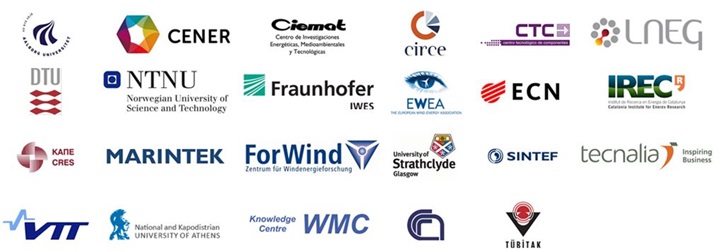
1. Introduction by the coordinator of the EERA JP Wind
We have now been well under way with the IRPWind programme for one year. The IRPWind is an unprecedented scheme co-funded by the European Union, designed to take the work done in the EERA JP Wind to the next level towards creating a European Integrated Research Programme on wind energy.
Throughout the first year of this pilot funding scheme, we have succeeded in setting up the programme. A main task during year one has been to improve the integration of national projects. This work is pivotal for one of the major objectives of IRPWind: further alignment of European and national research efforts within wind energy research in Europe.
Major tangible achievements in the first year have been the IRPWind yearly conference in Amsterdam and the successful completion of two rounds of mobility calls.
Since openness is crucial for the programme, IRPWind is beneficial not only for the project partners, but also for all the other EERA JP Wind current and future members.
EERA JP Wind members are eligible to apply for the Expression of Interests (EoI’s) in the work packages for mobility and research infrastructures. They can also benefit from other activities foreseen by the programme, including participating in workshops and in the yearly IRPWind conference.
The second year of the project will see concrete scientific results that cover, among others, the topics of design of offshore wind farms, structural reliability of wind turbines and wind farm cluster control.
Enjoy the reading.
Peter Hauge Madsen

2. EERA JP Wind news
IRPWIND strategy seminar in Trondheim
In February 2015, SINTEF Energy Research hosted an EERA JP WIND strategy seminar. Self-evaluation of the Joint Programme collaboration and coordination of national funding were the most important items on the agenda for the seminar.
Within the framework of the FP7 funding scheme of the EU, EERA JPWIND performed well in setting up the Joint Programme and starting several EU projects, including IRPWIND. Under Horizon 2020, JP WIND has already been successful with one project proposal.
Various actions were agreed upon during the strategy seminar (more info on this seminar will be given in the following sections), including the formulation of ‘Science Readiness Levels’ as a way to push for more medium to long-term research at European level. The Science Readiness Levels will be complementary to the Technology Readiness Levels already used as a frame of reference in recent EU calls.
Additionally, the internal procedures of JP WIND will be updated so to aim at more industrial participation and more scientific excellence, when formulating future JPWIND Horizon 2020 proposals.
The second part of the strategy seminar dealt with how we can improve the coordination of national funding within JP WIND. A major task for JP WIND in the years to come is to investigate how to implement the Berlin model among the EERA JP WIND members. The aim is to identify, coordinate and implement more joint projects between different EU member states. Within the field of wind energy, North Sea Offshore Network (NSON) project with respect to national alignment. A project like NSON requires international harmonization of national already aligned activities, which is not an everyday occurrence and requires a very good developed virtual environment of collaboration. Nevertheless, it is something we should strive for henceforward in JP WIND. The first step will be the submission of a LCE-19 proposal on supporting coordination of national R&D activities using NSON as a case to show the challenges implied in coordinating national funded projects.
Christian Orup Damgaard - DTU
Wind Energy

Successful EERA Deepwind 2015, Trondheim, 4-6 February 2015
The EERA DeepWind'2015 Deep Sea Offshore Wind R&D Conference was a success with a mix of plenary presentations with broad appeal and presentations in parallel sessions and posters on specific science and technology themes.
The conference is established as an important venue on deep sea offshore wind R&D organized in association with the European Energy Research Alliance (EERA) joint programme on wind energy. The aim is to present the latest and best on-going R&D on deep sea offshore wind farms.
In total 65 oral and 50 poster were presented addressing new turbine and generator technology, grid connection and power system integration, met-ocean conditions, operation & maintenance, installation and sub-structures, wind farm optimization, and experimental testing and validation. The conference was fully booked with 200 delegates from all over Europe, and also from USA and Japan. In addition to the exciting main event there were side events including a workshop on EERA IRPWind access to open data and an IEA Offshore Wind Code Comparison (OC5) meeting.
The presentations from the conference are available here, whereas selected papers are now in peer-review for publication in the open access journal Energy Procedia (Elsevier).
Mark your calendars: The next EERA DeepWind conference will take place in Trondheim 20-22 January 2016.
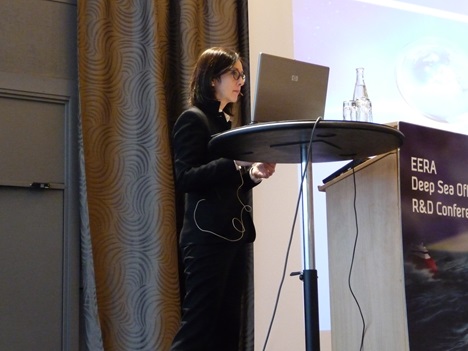
Susanna Galloni from the European Commission opened the conference with the talk "Progress of offshore wind through R&D in FP7 and H2020".
John Olav Tande, Sintef

EERA annual congress
On April 30th 2015 the EERA Secretariat organised the 5th Annual Congress of the European Energy Research Alliance in Brussels. With more than 220 participants and a mix of industry, research and policy representatives the congress has developed into a good networking platform and an important event in the SET-plan calendar.
This year, IRPWind was present at the congress with a poster and the fresh-from-print EERA JPWind brochure. This is important, because EERA wants to further improve the communication on what it is done and the impact that its work has. This was the recurring message from the Commission, from the Member States’ representatives and not least from EERA Chairman, Hervé Bernard.
Both JP Wind and IRPWind have good results to show in the areas where EERA is intended to make a difference: dedicated conferences and workshops, close collaboration with industry organisations, projects such as EERA-DTOC, increasing coordination of national research and much more.
Demonstration of the EERA JP’s capabilities and results are the responsibility of all IRP’s. Not only contractually with the European Commission, but also towards the rest of the EERA community. This is essential for the future of the European research on renewable energy.
Mattias Andersson - DTU Wind Energy and member of the EERA Secretariat
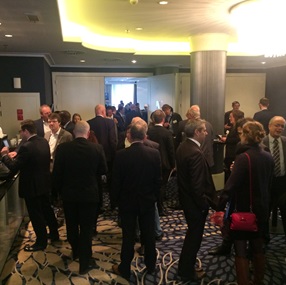
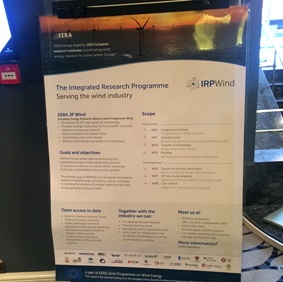
EERA annual congress in Brussels IRPWind was also present with a poster

The EERA JP Wind has published a brochure that shows how the Joint Programme boosts the international coordination of wind energy research.
The brochure is developed as part of the Integrated Research Programme for Wind Energy, IRPWind, funded under FP7. Quoting colleagues from US, Industry’s association and Ministry representatives, the brochure provides a good overview of how an EERA Joint Programme operates.
The brochure is available here and printed copies will be available at EERA and IRPWind events or it can be obtained as hard copy by contacting the secretariat here.
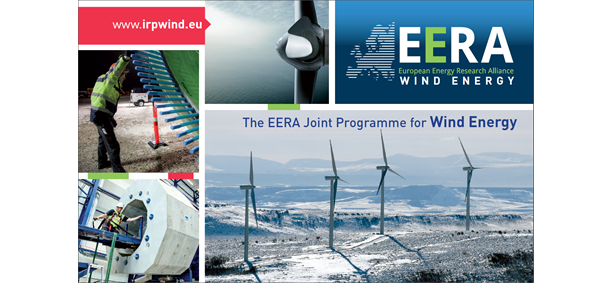

3. EERA JP Wind Sub-Programme (SP) news
The Joint Programme Wind Energy is further divided into 7 sub-programmes.
The H2020 LCE6 call ‘Transmission and Wholesale Markets’ addresses several objectives of the work plan of the sub-program Wind Energy Integration. Therefore, the SP decided to work out and submit proposals for this call. In addition, the JP Smart Grids started initiatives for proposals for the same call. Due to a good co-operation between JP Smart Grids and JP Wind Energy (SP Integration) in the past, we started a joint and co-ordinated procedure for the proposal process. This co-operation lead to the result, that 3 pillars (proposals) were defined – addressing different topics of the call:
− Transmission planning and security (SG)
− TSO/DSO interaction (SG)
− Ancillary services procurement (Wind)
In addition to this co-operation, representatives of JP Wind Energy and JP Smart Grids were invited to workshops of ENTSO-E, to discuss proposals for the LCE5 call and to present the R&D community. This workshop was jointly prepared be the JPs.
Kurt Rohrig – IWES/Fraunhofer

On the 13th of May a workshop for EERA Sub-Programme "Structures and materials" partners was held in Athens. Purpose of the workshop was to discuss progress of joint activities, potential alignment of running activities by forming joint actions and prepare for next calls on collaborative projects. Participants of 16 institutions from 9 EU countries attended the meeting, where several partners presented recent research findings on subjects of common interest. Additional collaboration in the field of structures and materials now becomes possible through the newly joining members of the SP – and this will be evident with the upcoming update of the SP description of work.
Denja Lekou - CRES

On 9 March 2015, the sub-programme ‘Economic and Social Aspects of Wind Integration’ organized a workshop entitled Public Engagement Strategies and Wind Energy. The purpose of the workshop, held in Roskilde, Denmark, was to gather social scientists and wind engineers from Europe, Turkey and the USA to discuss the state of the art and science of public engagement and identify key questions relevant for the wind community in EU and beyond. The invited keynote speaker, Prof. Dr. Ortwin Renn from the University of Stuttgart, began the workshop with a presentation on “The Lack of Public Acceptance: A New Experience for Wind Farms.” This kicked off a very rich dialogue among the over 30 participants. There were also 3 roundtables that addressed specific questions on the topic and a discussion at the end of the day that identified some important research questions for the EERA JP Wind Sub-Programme interested parties.
The group addressed some aspects of the grand challenges of climate change urgencies for moving towards a clean electricity transition and the need to engage in a meaningful dialogue with the public(s) about energy choices and needs. Bonnie Ram, a Guest Scholar at DTU Wind Energy and task leader for the EERA Sub-Programme on Public Engagement, was the organizer and moderator of this workshop.
Klaus Skytte - DTU Wind Energy
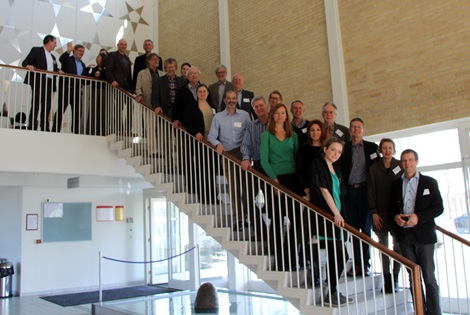
Group Photo from the Workshop at DTU Wind Energy, Denmark

IRPWind @ EWEA Offshore 2015 - Copenhagen
After diving deeper into the content of each work package of the project, he concluded that not only the industry should unite, but the research community should unite with them. Only then we can maximize the impact of R&D and shorten the time to market of R&D efforts. IRPWind will continue to convey this message and further intensify EERA JP Wind’s link to the industry.
|
At EWEA Offshore 2015, in Copenhagen, Peter Eecen (ECN) had the opportunity to presentIRPWind to the industry. In the presentation at the Speaker’s Corner, he explained why it is essential for the European research community to strive for integration of research infrastructures, and how EERA JP Wind is planning to achieve this.
Peter Eecen started by explaining the mission of the European Energy Research Alliance (EERA) and how it brings together 150 research institutes under the Joint Programme (JP) Wind umbrella. With the IRPWind project consisting of both integration and R&D-related work packages, the goal will not only be to inventory the available knowledge and facilities, but also to agree on a common strategy for the middle and long term wind research. The emphasis will be on the dialogue with the industry, to ensure alignment.
After diving deeper into the content of each work package of the project, he concluded that not only the industry should unite, but the research community should unite with them. Only then we can maximize the impact of R&D and shorten the time to market of R&D efforts. IRPWind will continue to convey this message and further intensify EERA JP Wind’s link to the industry.
|
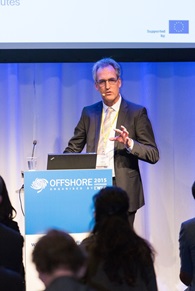
|

After the IRPWind general assembly in Copenhagen, IRPWind initiated a LinkedIn group aiming to inform a broad audience. We encourage all participants to start discussions on the various posts that you will already find. Keep a close eye on the group, as there will be regular news items that are ‘posted’ by IRPWind partners.
Join the IRPWind LinkedIn Group.

IRPWind conference 2015 open for registration
The dates for the IRPWind conference 2015 are set. On September 28th and 29th the results of all EERA projects will be shared among the attendees. All sub-programmes will have the opportunity to hold a specific workshop. The conference is free of charge and will host industrial and member state representatives as well.
Moreover, the registration is now open and can be completed through this form.
Martijn van Roermund - ECN

IRPWind and EERA-DTOC @ EWEA Paris 2015
The latest developments of the IRPWind project will be presented during EWEA 2015 Annual Event that this year takes place in Paris, from the 17th to the 20th November 2015.
The EWEA Annual Event is the leading pan-European event for the wind energy sector and participants are expected from more than 60 countries all around the globe. In a joint session with EERA-DTOC, IRPWind will have the opportunity to disseminate its preliminary results and to share the outcome with an extended audience of industry leaders, policymakers, potential customers and business contacts.
Presenting these results will be an important opportunity to receive feedback from industry and other relevant stakeholders. We invite interested parties to get in contact with the IRPWind team through the contact details mentioned at the end of the newsletter.
Edit Lulu Nielsen - EWEA

Mobility - How long is long enough ? (WP5)
After one year, the IRPWind mobility programme is taking off, gaining popularity. There is no doubt about the interest for the programme as we are receiving an increasing number of questions about rules and procedure for participation.
Looking back to the first 12 months of IRPWind, we had 12 applications. Only one application was not successful, since it was aiming at an exchange with the USA.
The majority of questions that we receive concern the length of the grants. Currently, the duration of the mobility period can be of one, three or six months. Statistics for the first 12 months of the IRPWind mobility programme are:
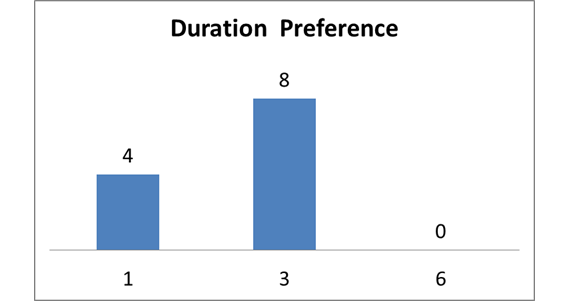
The preferred length is 3 months. The 6-month scheme has never been selected, which indicates that participants prefer short to medium-term stays. Interesting enough, an applicant indirectly applied for six months, as he wanted to spend two 3-month periods in two different institutions.
So, how long is long enough?
Further evaluation will take place in the next Management Board meeting. Keep informed about the developments of the mobility programme at this website.
Anna Maria Sempreviva - DTU
Wind Energy

IRPWind WP6 offshore is in excellent progress
The work in WP6 Design of offshore wind farms is on schedule with the first deliverable submitted in April. The objective of the WP is to accelerate the design optimization of wind turbines and support structures for offshore wind farms, through validation of integrated design models, and subsequent development of methods and design criteria. The first deliverable is vital for achieving this in setting out a model evaluation protocol for offshore design codes. This has been prepared by CENER in a joint effort with the other participants in WP6.2 that shall continue works on benchmarking of numerical models.
Work is now also started in WP6.1 led by University of Hannover preparing data assimilation and in WP6.3 led by University of Strathclyde preparing model development. The next deliverables are in August 2015 including definition of conventions and first data structures (61.1), an inventory of design codes for offshore wind turbines (62.3) and an inventory of test cases for the validation of offshore design codes (62.4). Activities are coordinated with EERA SP offshore wind energy sharing knowledge for joint benefits and efficient use of resources through expert workshops and conferences.
John Olav Tande, Sintef

Testing of blade subcomponents (WP7)
The first technical report “Methodology for testing subcomponents: background and motivation for subcomponent testing of wind turbine rotor blades” was submitted earlier this year. The report aims at providing an overview of the design methodology followed by wind turbine blade structural designers, along with the testing procedure on full scale blades which are followed by testing laboratories for blade manufacturers as required by the relevant standards and certification bodies’ recommendations for design and manufacturing verification.
The objective of the report is not to criticize the design methodology or testing procedure and the standards thereof followed in the wind energy community, but to identify those items offered by state of the art structural design tools that cannot be verified through the currently followed testing procedures and recommend ways to overcome these limitations. The recommendations provided in the report are relevant for the design and testing of wind turbine subcomponents, in order to verify the numerical analysis tools used in the structural design of wind turbine blades.
Denja Lekou - CRES

Technical meeting - Preparation for subcomponent testing (Wp7)
On May 12th the second technical meeting among the participants of work-package 7 was hosted by CRES. Progress and work plan for the next period were discussed. First tests on wind turbine blade subparts and model support structures are planned for the end of the year 2015 and the issues involved to achieve that were the focus of discussions during the meeting. Due to the interconnecting structure of WP7, a strong interaction between the different work packages and the research teams involved is required; the meeting formed the perfect opportunity to discuss topics of interest for all partners.
Denja Lekou - CRES

5. Suggestions and feedback?
If you have any topic suggestions for the next newsletter, or if you have ideas on how to improve it, feel free to send your input to Martin van Roermund at ECN.
You can subscribe or unsubscribe the newsletter here.
